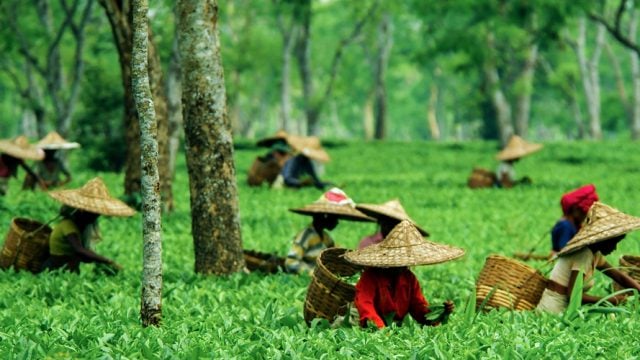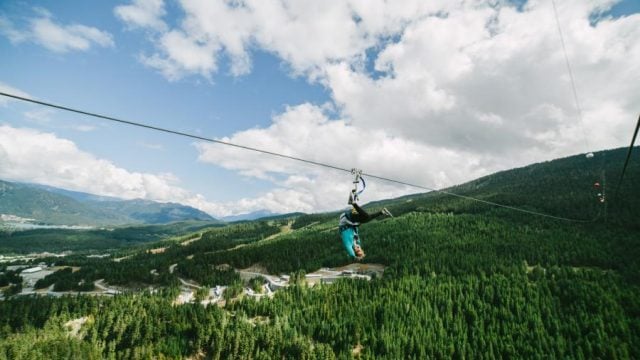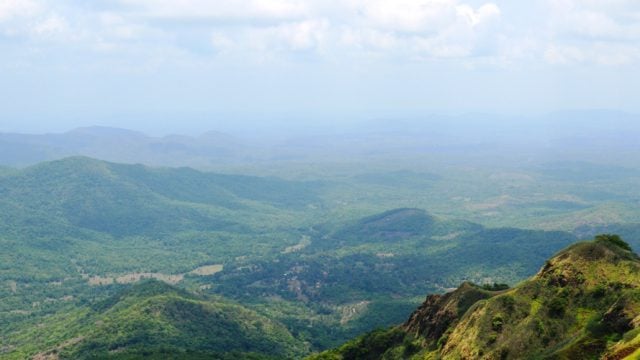TO READ PART 1 OF THIS STORY, CLICK HERE Route: Gwaldam-Joshimath-Auli
Distance: 152 km
Time: 5
The condition of the road beyond Gwaldam is very poor. Make sure you leave the town early in the morning, after a hearty breakfast, to reach Joshimath before sun down. Ask locals about road conditions as you drive on, and follow the Pindar river to Karnaprayag.

Karnaprayag (2,585 ft) is situated at the sacred confluence of the Alaknanda and Pindar rivers. It is said that this was where Karna, son of Kunti and the sungod Surya, meditated to be bestowed with the impregnable kavach (armour), kundal (earrings) and tuneer (arrow case), which made him invincible. Stop in the town only to grab a quick late lunch at the restaurant in Shri Krishna Place (Tel:01363-244260, Cell: 09410416231) before heading northeast to Joshimath via Chamoli. Drive slowly on this stretch; the road here is built on dangerous mountain terrain, with hills on one side, and a sheer drop on the other, with the Alaknanda river flowing below.
Adi Shankaracharya is said to have wandered into Joshimath and gained enlightenment here. The town offers spectacular views of the Nanda Devi and surrounding snow-capped peaks. Joshimath provides access to Auli via the GMVN cable car. The cable car is the safest route to take to Auli since the route is scattered not just with stones, pebbles and rocks, but even boulders, and might be hazardous for your vehicle. Spend the night in Joshimath and take the cable car up to Auli early the next morning.
Things to See & Do
The Garhwal Mandal Vikas Nigam (GMVN), at Auli, offers skiing courses for beginners from January to March. You can also learn privately from the freelance instructors hanging about the slopes. Fees for the GMVN skiing course includes boarding, lodging (shared), ski equipment, lift and training. You can also opt for per day charges.

Located between 9,500 and 10,500 ft high, the ski resort of Auli covers a stretch of just about 5-7 km, but commands excellent views of the surrounding peaks, some of which soar well over 23,000 ft. The air here is cold, fresh and scented with pine. The GMVN cable car traverses 4 km up the hill from Joshimath, transporting you over the tops of oak and fir trees to Auli. And when you ski down the slopes, you don’t have to worry about the trudge back up: the baby slopes have a 1,640-ft-high ski lift, and the advanced slopes have a 2,620-ft-high chair lift to haul you to the top. Unlike other winter resorts, which offer tobogganing and sledding, there is only one thing to do here: ski. But watching the sun rise behind Nanda Devi, gazing up at the sky at night, or watching snowflakes float gently to the ground, make up for the lack of other activities. Spend a night in the magical town and take the first cable car down to Joshimath the next morning.
Things to See & Do
Joshimath, connected by the ropeway, can serve as a base for Auli. The seat of Adi Shankaracharya, this town is home to the Narsingh and Garuda temples. The Shankaracharya Cave, nearby, is where the sage is believed to have attained his jyotirdarshan or enlightenment. Pandukeshwar, the winter seat of Badrinath, is 21 km away.
Route: Joshimath-Ranikhet
Distance: 216 km
Time: 7 hours
The drive from Joshimath to Ranikhet is long, and best divided into two parts with a lunch break at Karnaprayag. The road ahead is a barren stretch with no petrol stations; make sure you head out of Karnaprayag with a tank full of fuel.

Ranikhet is one of those rare destinations that gives nature precedence over man– you will find a sign that cautions, “Leopards have the right of way.” So do the monkeys that swing through its trees and the deer that hide in its groves. This forested paradise was established by the British in the 1860s. Ranikhet and its twin Majkhali are spread along a 15-km-long ridge that affords one of the most magical views of the Himalayas.
Things to See & Do
Ranikhet is best experienced by walking along its lanes or hiking through its pine, oak and deodar forests. Carry binoculars; you may just spot the great Himalayan whistling thrush, scarlet minivet, Himalayan tree pie, red-billed long-tailed blue magpie, flying squirrel, a troupe of monkeys, barking deer, or even a leopard.
Ranikhet has several temples, but the most venerated are the Jhula Devi Temple and the Kalika Devi Temple, principal deity of the Kumaon Regiment.
Stop by the Kumaon Regiment Museum, located above the SDM’s office, which showcases the history of the Kumaon and Garhwal regiments.
One of the first Raj-era hill gardens, Chaubatia Orchards is a pleasant place to spend time in. It houses the region’s first Horticulture Research Institute. The café at sunset viewpoint here serves decent coffee. Don’t forget to buy fruits from the orchard before heading out.
Ranikhet’s green meadows around Upat and Kalika Devi Temple were turned into a 9-hole golf course around the 1920s. A game of golf here costs ₹ 250, caddie and golf club charges are extra. The rights of admission and play are however, at the discretion of the army.
Shopping
Zaroori Bazaar has a large number of jewellers selling silver ornaments and silver embossed images of gods as well as goddesses in copper frames. While on the Mall, do check out the Shawl and Tweed Factory (Tel: 05966-220357) run by the Army Wives and Widows Association. The souvenir shop at the Post and Telegraph building also offers shawls and tweed, besides locally made jams and pickles.
Route: Ranikhet-Corbett National Park
Distance: 79 km
Time: 2 hours
After a leisurely day at Ranikhet, wake up early the next morning for the drive to Corbett. While the roads here are good, it is best to drive cautiously and slowly since sections of the road have sheer drops on both sides.

Located in the foothills of the Himalayas, Corbett National Park was the first sanctuary to come under Project Tiger in1973. The park is bisected by the Ramganga river, the Kosi river and their many tributaries. It has two main tourist zones. To the south-east, nearest to Ramnagar, is the smaller portion called the Bijrani Range (entry through Amdanda Gate). The other, much larger, range is Dhikala. Entry here is through Dhangarhi Gate and is restricted to those who have a permit to stay overnight in any one of the five FRHs. However, vehicles operated by the Forest Department for day visits are allowed in even without a FRH stay permit. Walking, is prohibited, and the park closes at sunset.
Take an early-morning and an afternoon safari into the park – you might just spot a tiger. But even if you don’t, keep your eyes peeled and your ears cocked for the other inhabitants –the area abounds in exotic and common birds, as well as ghariyals, cheetal, elephants and sambars, among other mammals.
Things to See & Do
The best way to see the flora and fauna in the park is on a safari. Travelling by jeep offers you the best chance of seeing a tiger in the national park; jeep safaris leave from the Bijrani, Jhirna and Sonanadi gates. Taking an elephant safari is an experience in itself, and though the chance of seeing a tiger from elephant back is less, the thrill is even greater. Elephant safaris leave from the Bijrani and Dhikala gates.
Park Entry Indians ₹100; Foreigners ₹450; Safari timings 6.00-10.00am &2.00-6.00pm; Vehicle fee Indians ₹250,Foreigners ₹500; Bus ₹1,500, mini bus ₹800, jeep ₹500
Angling is allowed in the Ramganga, Kosi, Mandal and Kothri rivers with a special permit. You can fish upstream of Domunda Bridge (11 km from Durgadevi Gate) on the Ramganga river. Fishing permits are available at certain spots along the river. The park also encompasses the Kalagarh Dam – a great attraction for many species of migratory birds. Don’t forget to visit the Corbett Museum at Kaladhungi (32 km).
Route: Corbett National Park-Delhi
Distance: 234 km
Time: 5 hours
From Ramnagar follow the NH121 and the Kashipur-Moradabad road to NH24 and then signage along the road to Delhi. The final leg of the drive seems drab in comparison to the rest of the route – you are back in the plains having left the glorious hills behind.
Tips & Tricks
>Avoid driving at night on any stretch –driving in the hills at night can be dangerous for the best of drivers.
>Carry plenty of food and water with you – on certain stretches, you’ll be lucky to get even a packet of chips.
>Tank up wherever you can – you may not come across petrol pumps for miles on end.
>Mobile phone connectivity is usually patchy after Nainital.
Stopovers
Gwaldam
Where to Stay: The Raj-era Forest Bungalow (DFO Badrinath Tel: 01372-252175; Tariff: ₹300-1,500), situated by a small lake, has fabulous views. Guests can cook their own meals in the well-equipped kitchen here.

Nature’s Treat Resort (Tel: 01363-274389, Cell: 09412117721; Tariff: ₹1,500-2,200) is the best private option. The hotel’s restaurant has room service. Trishul Guest House (Tel: 274389, Cell: 09412117721, 09634587885; Tariff: ₹200-800), offers basic rooms, and has an old-world charm.
The GMVN TRH (Tel: 274244; Tariff: ₹300-860), right atop the busy market, is at a noisy spot and the rooms are unkempt. Come here to book guides for your treks.
Where to eat: Midpoint in the market serves decent snacks and sweets, while dhabas in the tiny market square serve basic north-Indian meals.
Joshimath
Where to Stay & Eat: Hotel Dronagiri (Tel: 01389-222221, 222622; Tariff: ₹1,500-4,500, 5-bed dorm ₹3,000) has a restaurant that serves north-Indian, Chinese and Continental fare.
Hotel Snow Crest (Tel: 222575; Tariff: ₹1,500-3,500) has a restaurant and offers games and trekking.
The GMVN-operated Jyothir Tourist Complex (Tel: 222118, Cell: 09568006667; Tariff: ₹650-2,090, dorm ₹140-220 per bed) offers a choice between rooms and dorms.
The Himalayan Abode (Tel: 222687, Cell: 09412082247; Tariff: ₹2,850-3,850) on the Badrinath Highway has yoga, meditation and sightseeing.
The peak-facing Hotel Mount View (Tel: 221993, Cell: 09871212938; Tariff: ₹3,250-5,400, dorm ₹600 per bed) is in Upper Bazaar.
Nanda Inn (Tel: 222446, 221021, Cell: 09837937948; Tariff: ₹2,500-7,500) has a restaurant, coffee shop and yoga hall.
To stay right near the ropeway to Auli, choose Hotel Kamet (Tel: 01389-222155, Cell: 09412918488; Tariff: ₹700-1,500, 8-bed dorm ₹1,600) or Hotel Snow Crest, which has rooms with attached baths and 24-hr Internet facility.
Auli
Where to Stay & Eat: The popular Cliff Top Club Resort (Ramnagar Tel: 05947-253232, Cell:09313310640; Tariff: ₹12,000-16,000) is located right on the ski slopes. Cliff Topalso offers skiing, rock climbing, naturewalks and camping.
Other options in Auli are the GMVN Skiing and Tourist Resort (Tel: 01389- 223208, 223305; Tariff: ₹1,650-4,400), Himalayan Eco Lodges (Gurgaon Tel: 0124-4081400; Tariff ₹3,000) as well as the Royal Village Auli Resort (Tel: 223221, Cell: 09639419882; Tariff: ₹3,000).
The resorts are your only meal options. There are no bars nearby.
Ranikhet
Where to Stay: Chevron Rosemount (Tel: 05966-221391, 220989; Tariff: ₹9,999-19,999 for 3D/ 2N) rents out rooms or an independent cottage. The same management also runs Ranikhet Club (Tel: 220611; Tariff: ₹3,500). Formal wear is obligatory for men to access the bar here.

Built in the late 1860s, Holm Farm (Cell: 09411113263; Tariff: ₹3,700-8,400, with two meals), offers stunning views.
West View Hotel (Tel: 220396;Tariff: ₹7,500-28,000 for 3D/ 2N) is housed in a lovely heritage stone building constructed in 1918.
The Ranikhet Inn (Tel: 221929, Cell: 09410762760; Tariff: ₹2,500-4,200) is a mid-range option near the market. There’s also the KMVN Kalika Tourist Rest House (Tel: 220893, Cell: 08650002533; Tariff: ₹1,700-2,800), a budget option on The Mall.
Where to Eat: Moon Hotel and Restaurant (Tel:05966-220382) serves north-Indian fare. Ranikhet’s main bazaar has restaurants that offer fast-food meals, besides the all-time favourite, Softy ice-cream. Ranikhet Inn offers pizzas on its menu. But don’t miss the small tea stalls that prepare delicious samosas in the evenings. Nor the famed bal mithai, available at Ranikhet’s many halwais. If you’re looking for a more elaborate meal, head for Chevron Rosemount, West View Hotel or the slightly more remote Holm Farm. Be sure to let them know in advance. The filling Continental breakfast at Hotel Meghdoot is just what you need before a walking tour.
Corbett National Park
Where to Stay & Eat: To stay at any of the Forest Rest Houses (Contact Main Reception Office Tel: 05947-251489, 253977), you will need to make your reservation in Ramnagar and obtain a permit. Corbett’s main camp, Dhikala Forest Lodge (Tel:251489; Tariff: ₹1,250-2,750, log huts ₹250 per bed), 40 km north-west of Ramnagar, is beautifully situated. Bijrani FRH (Tel: 251489; Tariff: ₹1,250-2,000, log huts ₹300 per bed) is much smaller, but located 9 km from Ramnagar. Sarapduli FRH (Tel: 251489; Tariff: ₹2,000, log huts ₹300 per bed) is further into the park. You will need to make your own food arrangements when you book online.

Among the private resorts, theCorbett Hideaway (Tel: 284134, Cell:09760691472) is a 3-star resort situated on the perimeter of the park, currently under renovation. Corbett Riverside Resort (Delhi Tel: 011-29551191/ 6688, Cell: 09811109596; Tariff: ₹12,900-30,000, for 3D/ 2N, with meals) overlooks the Kosi river. Jim’s Jungle Retreat (Delhi Tel: 011-43516376, 47537647, Cell: 09711789828; Tariff: ₹18,000-22,000) is beautifully designed yet homely.
The 3-star rated Infinity Resorts (Gurgaon Tel: 0124-4655800/ 04, Cell: 09650193664; Tariff: ₹8,800) is located 8km from Ramnagar Railway Station, on the banks of the River Kosi. Close to Bijrani Gate is Corbett Leela Vilas (Tel: 284330/ 32; Tariff: ₹24,000, for3D/ 2N, with meals), which offers 12 luxury cottages.
Auli
Corbett National Park
Drives





